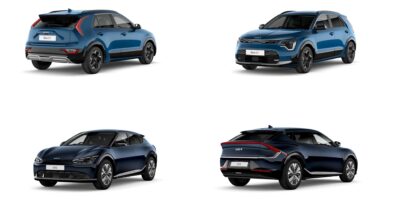Lexus has strengthened the appeal of its UX compact urban SUV, its best-selling model in the UK, with upgrades for both the self-charging hybrid electric UX 250h and battery electric UX 300e.
Both adopt a new multimedia system that provides improved connectivity, faster performance and easier operation. New features include eight or 12-inch touchscreens, cloud navigation and the introduction of new “Hey Lexus” onboard voice assistant.
The principal technical change for the UX 300e is the introduction of a new, more powerful battery which helps increase the car’s driving range by around 40 per cent, up to 280 miles*. Other tweaks to the body and chassis contribute to an even more engaging and refined driving experience.
Other changes include enhanced and additional Lexus Safety System+ functions, a new F Sport Design grade and a bi-tone paintwork option for the UX 250h.
The new UX 250h is available to buy now; the new UX 300e will be launched in the UK during the second half of 2023.
Self-charging hybrid electric UX 250h
The self-charging hybrid electric UX 250h is powered by a combination of a 2.0-litre petrol engine and two electric motors. This system produces a total power output of 181bhp/135kW.
Both front and all-wheel drive versions are available, the latter deploying Lexus’s electronic E-Four system which uses a separate high-torque motor generator on the rear axle. This immediately supplies drive torque to the rear wheels when the car’s stability control system (VSC) detects any loss of grip from the front wheels. The front/rear power distribution is automatically optimised to help maintain grip and keep the vehicle stable. As well as giving more secure performance on loose or slippery surfaces, it also improves stability when cornering by adjusting rear-wheel power to correct over or understeering.
The rear motor also acts as an energy generator for the UX’s regenerative braking system, so more kinetic energy can be captured when the car brakes or slows and stored as electricity in the hybrid battery.
Battery electric UX 300e
Launched in the UK and Europe in 2021, the UX 300e was Lexus’s first battery electric vehicle (BEV), developed with the benefit of the company’s 15 years of electrification expertise. Lexus’s world-class know-how in battery design, manufacturing and management systems has supported the development of a significantly more powerful battery for the car, to be introduced in 2023.
The lithium-ion battery’s capacity has been increased from its original 54.3kW/h to 72.8kW/h. As a result, although the vehicle’s maximum output remains 201bhp/150kW, it is able to cover a greater distance on a full charge. The current UX 300e has a WLTP range of up to 196 miles (running on 17-inch wheels); the new model’s range is up to 280 miles on 17-inch rims, or 273 miles with 18-inch wheels*.
Detailed changes to enhance the driving experience include fine-tuning of the steering and shock absorber settings to sharpen dynamic performance, while additional spot-welding increases body rigidity. These alterations improve the car’s responsiveness and planted feel, characteristics accentuated by the vehicle’s low centre of gravity and the location of the battery pack beneath the floor. Changes are also being made to the sound insulation to achieve an even quieter cabin.
European sales success
The UX is Lexus’s best-selling model in Europe and closely rivals the mid-size NX model in the UK market.
Electrified vehicles accounted for 96 per cent of all Lexus sales in Western Europe in 2021 (more than 99 per cent in the UK). In tune with contemporary customer preferences, SUV models currently command 87 per cent of Lexus’s new car sales in the region. Last year, the UX led the way with 21,144 units sold, just ahead of the NX and large RX self-charging and plug-in hybrid electric vehicles, which sold 19,493 units and 18,346 units respectively.
The key decision factors for UX buyers are the electrified powertrains; Lexus’s strong brand reputation; fuel consumption and energy efficiency; general durability; and prestige. The UX also appeals to younger customers as a gateway model for Lexus’s luxury range.
The flexibility of an SUV, the driving characteristics of a hatchback
The UX has its origins in Lexus’s ambition to develop a “Creative Urban Explorer,” a vehicle that offers both the secure feeling of a crossover/SUV and the driving quality of a sophisticated hatchback.
In the UX, Lexus’s world-class refinement and quietness levels are combined with dynamic characteristics which prove that driving can still be enjoyable with the higher-riding practicality of an SUV.
The car is built on Lexus’s GA-C global architecture platform, a light structure which is also exceptionally rigid, sharpening responses to driver inputs. The new model enhances chassis performance with the introduction of a more rigid steel back door reinforcement and additional spot welds on the back panel and side members.
The 2,640 mm wheelbase contributes to a smooth and stable ride, as well as cabin roominess, while the 10.4 m kerb-to-kerb turning diameter makes manoeuvring and parking easy. Ride and handling also benefit from the UX’s low centre of gravity, achieved partly by locating the battery beneath the floor under the rear seats in the UX 250h and under the full cabin floor in the UX 300e, as well as by using lightweight aluminium for the side doors, wings and bonnet, and composite materials for the tailgate.
The UX evokes the feel of a dynamic, luxury hatchback the moment the driver settles behind the wheel: despite the higher seating position, there is a relatively short hip-to-heel distance which gives the driver the feeling of being closer to the ground than in other SUVs.
On the move, Lexus Drive Mode Select allows the driving experience to be tailored to suit the conditions or driver preference. Normal drive mode provides an optimal balance between driving performance and fuel economy; ECO mode maximises fuel savings by smoothing the throttle response and moderating air conditioning operation; and Sport mode delivers quicker throttle response and increased steering feel.
In F Sport models, which are now equipped with Adaptive Variable Suspension (AVS) as standard, the number of driving modes increases from three to five: Normal, ECO, Sport S, Sport S+, and Custom. By selecting the Sport S+ or Custom modes with the chassis setting in SPORT, the AVS’s damping force control switches to firmer settings to provide a more dynamic driving feel. The Custom mode allows the driver to freely combine the modes of the powertrain, chassis, and air conditioning functions to suit their preference.
New F Sport Design grade
The F Sport Design grade is an addition to the UX 250h range, making powerful F Sport exterior styling accessible to more customers.
Its road presence is enhanced with the F Sport spindle grille, featuring a Lexus L-motif mesh pattern, finished in black with a chrome surround for the lower section that accentuates the car’s planted stance. The same pattern is featured in the enlarged bezels housing the fog lights and cornering lights in the F Sport front bumper, with contrasting chrome L-shaped surrounds. The rear bumper also has an F Sport-specific design, with jet black roof spoiler and moulding details around the light clusters. The 18-inch F Sport alloy wheels have a 10-spoke design and a dark metallic finish.
Other F Sport Design standard specification details include synthetic leather seat upholstery, heated front seats, dual-zone automatic air conditioning with Lexus’ Nanoe-X air quality system, reversing camera, automatic wipers, LED headlights with Automatic High Beam, chrome roof rails, black wheel arch mouldings and Lexus “F” badging.
UX 250h F Sport
The UX 250h F Sport now includes as standard Lexus’s Adaptive Variable Suspension (AVS), rear performance shock absorbers, and front and rear performance rods (strut braces).
The AVS provides continual adjustment of the damping force at each wheel, responding to signals from steering, yaw rate, and linear G-sensors. This results in sharper handling and chassis response, reduced body roll when cornering and smoother ride quality. The AVS’s control system has been adjusted so there is a seamless shift to high damping force. It is also tuned to reduce high and mid-frequency vibration.
There is also an even more precise steering feel, thanks to a new rigid joint between the top of the steering gearbox mount and the front suspension member. To optimise the benefits of this, shock absorber damping force has been fine-tuned, enhancing the linear steering feel.
Lexus Safety System+
Revisions to the UX‘s Lexus Safety System+ bring improved performance in the Pre-Collision System, equipping the car with Intersection Turning Assist for safer left and right turns across traffic at intersections and Emergency Steering Assist, which helps the driver to steer to avoid obstacles without departing from their traffic lane. The Dynamic Radar Cruise Control adopts Curve Speed Reduction, which automatically adjusts the vehicle’s speed to suit the radius of a bend in the road.
*Article Source www.lexus.co.uk








